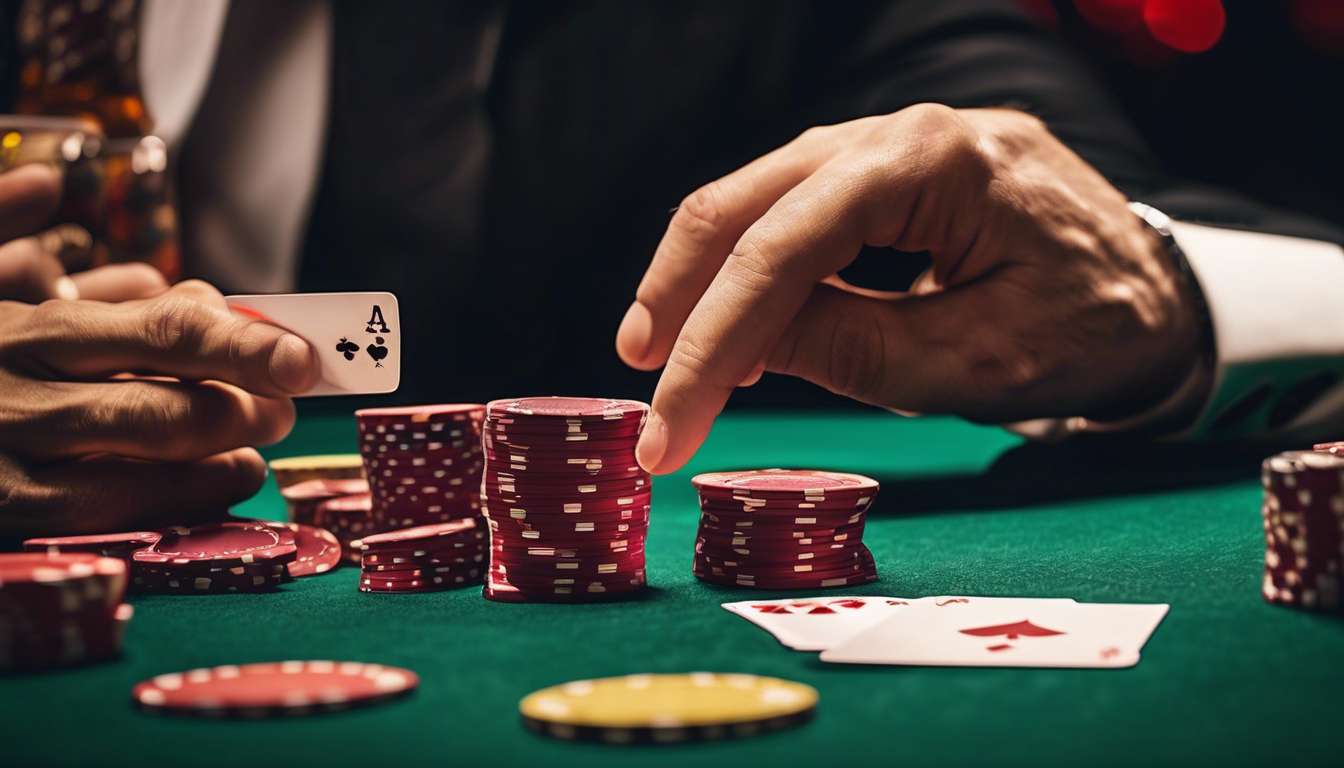As avid blackjack enthusiasts, we know the thrill of sitting at the table, cards in hand, and feeling the rush of anticipation with each flip. Blackjack, a game of skill and chance, is more than just a simple comparison of numbers; it’s a language of its own, rich with terms that can make or break our game.
Understanding these terms not only enhances our strategic play but also deepens our appreciation of the game’s nuances. In our journey through the blackjack world, we’ve come across terms that every player should know, whether you’re just starting out or refining your skills. These key phrases and concepts are essential tools in navigating the blackjack table with confidence and finesse.
Join us as we explore the top six blackjack terms that have become indispensable in our quest for mastery and success at the table. Let’s dive into the lexicon of blackjack and elevate our game together.
Basics of Blackjack
Basics of Blackjack
In the basics of blackjack, we’ll explore the fundamental rules and strategies that guide players in this classic card game. Understanding these core elements makes blackjack both challenging and rewarding.
Objective
- The primary goal is to get your hand value as close to 21 as possible without going over.
Strategy Importance
- Blackjack strategy is essential as it helps us make informed decisions, increasing our chances of winning.
Key Betting Options
- Hit: Request another card to try to improve your hand.
- Stand: Keep your current hand and end your turn.
- Double Down: Double your initial bet and receive exactly one more card.
- Split: If you have a pair, you can split them into two separate hands, each with its own bet.
Each decision affects your overall strategy and potential success.
For instance, with a pair of eights, splitting is generally a solid move, giving you a better opportunity to improve your hand.
Conclusion
By mastering these basics, we create a sense of unity and shared purpose as we navigate the tables, confident in our collective understanding and approach.
Soft Hand vs. Hard Hand
In blackjack, understanding the difference between a soft hand and a hard hand is crucial for making strategic decisions.
When we play together, knowing our hand types helps us navigate the game with confidence.
Soft Hand:
- Contains an Ace valued as 11.
- Example: An Ace and a six.
- Offers more flexibility since the Ace can also count as one.
- Minimizes the risk of busting if we decide to hit.
Hard Hand:
- Lacks the buffer of an Ace valued as 11.
- Any hand without an Ace or with an Ace valued at one.
- Example: A ten and a six.
- Requires more cautious decision-making due to a higher risk of going over 21.
Strategic Implications:
Our blackjack strategy should account for these differences as we decide whether to hit or stand. By mastering these hand types, we strengthen our sense of camaraderie and improve our collective gameplay experience.
Double Down
Doubling down can be a powerful move when we feel confident about our hand and want to maximize potential winnings. In our shared journey through the world of blackjack, understanding this option is crucial.
When we double down, we’re essentially doubling our initial bet, but only drawing one more card. This betting option is a key component of any solid blackjack strategy.
When to Double Down:
- We typically use this move when we believe our hand has a strong chance against the dealer’s upcard.
- For instance, if we have a total of 10 or 11, and the dealer shows a lower card, it’s an opportunity we don’t want to miss.
- By doubling down, we’re increasing our potential payout when the odds are in our favor.
Importance of Hand Types:
Recognizing when our hand is strong enough to double down unites us with other skilled players who understand blackjack’s nuances. Together, we elevate our game, making informed choices that enhance our collective experience.
Splitting Pairs
Splitting pairs gives us a strategic edge by allowing us to turn a single hand into two separate hands, potentially doubling our chances of winning. In the world of Blackjack strategy, knowing when to split can make a significant difference. When we encounter two cards of the same value, we’re presented with an exciting opportunity to explore new betting options and maximize our potential gains.
By splitting pairs, we take control of the game, creating two distinct hand types that can be played independently. This move is particularly effective with pairs like aces and eights, where splitting can lead to more favorable outcomes.
Our community of players understands that the key to success lies in making informed decisions, and splitting pairs is a powerful tool in our arsenal.
Together, we can elevate our game by mastering this technique, ensuring we’re not just participants but savvy players who know how to seize the moment.
Let’s embrace the challenge and enhance our Blackjack experience!
Insurance Bet
The Insurance Bet in Blackjack
One intriguing option available in the game of Blackjack is the insurance bet, which offers a form of protection against the dealer having a natural blackjack.
- When the dealer’s face-up card is an Ace, players can opt for this side bet.
- It acts as a hedge, providing a sense of security in one’s Blackjack strategy.
Cost and Payout
- The insurance bet costs half of the original bet.
- If the dealer does have a blackjack, the bet pays out at 2:1, allowing players to break even on that hand.
Strategic Considerations
As players explore different betting options, it’s essential to consider the type of hand held:
- If the hand is strong, one might choose not to take insurance, confident in their chances.
- Understanding when to use the insurance bet can be a valuable part of the overall strategy.
Community Aspect
Engaging with the insurance bet creates a sense of camaraderie with fellow players who appreciate the nuances of the game. Together, players make informed decisions to enhance their overall experience.
Surrender Option
In some Blackjack games, the option to surrender our hand early can be a valuable component of a solid Blackjack strategy. By opting for the surrender option:
- We forfeit half of our bet.
- It allows us to save the other half.
Surrendering is a smart move when faced with unfavorable hand types, like a hard 16 against the dealer’s strong upcard, such as a 10 or Ace.
As a community of Blackjack enthusiasts, understanding our betting options is key to feeling confident at the table. This sense of belonging comes from making informed decisions together.
The surrender option might not always be available, but when it is, it can be an effective tool in our arsenal. By surrendering at the right time, we can:
- Protect our bankroll.
- Extend our playing time.
Let’s embrace this strategic choice and enhance our collective Blackjack experience!
Bust
One of the biggest pitfalls we face in Blackjack is going bust, which happens when our hand exceeds 21. It’s something we’ve all encountered, and it’s crucial we navigate it wisely to stay in the game.
Knowing when to hit or stand is a key part of our Blackjack strategy. We need to assess our hand types carefully, whether it’s a hard hand or a soft hand, and make decisions that minimize the risk of busting.
Our betting options play a significant role in how we manage the risk. Consider the following choices:
- Doubling down
- Splitting a pair
Each choice can either lead us closer to victory or push us over the edge. It’s about finding that sweet spot where our hand is strong enough to compete without crossing the line.
Together, we can sharpen our strategies and make smarter choices at the table. Let’s aim to keep our hands under control and avoid the dreaded bust, ensuring we stay in the game longer.
Hole Card
In Blackjack, the dealer’s hole card remains face down, creating suspense and significantly impacting our decision-making as we try to anticipate the dealer’s hand. This hidden card is crucial to our Blackjack strategy as it influences whether we should:
- Hit
- Stand
- Double down
- Split
When we see the dealer’s upcard, we instinctively compare it to our hand types, considering various betting options based on potential outcomes.
Knowing how to react to the hole card enhances our sense of camaraderie at the table. We share in the thrill as we attempt to outsmart the dealer together. This shared experience helps us feel connected to our fellow players as we collectively navigate the game’s uncertainties.
By understanding the hole card’s role, we can better manage our bets and optimize our chances of success. So, let’s embrace the challenge, refine our strategies, and enjoy the unity that comes with playing this classic game.
What is the origin of the game of Blackjack?
Blackjack’s origin dates back to the 18th century in France, where it was known as "Vingt-et-Un," meaning twenty-one.
Evolution of Blackjack:
- The game has undergone various changes in rules and strategies over time.
- Its evolution has been influenced by different cultures and gaming practices.
Popularity:
- The game’s simplicity and excitement have greatly contributed to its widespread popularity today.
These elements have helped Blackjack become a staple in casinos worldwide.
How does card counting work, and is it legal in casinos?
Card Counting Overview
Card counting involves mentally tracking the cards that have been dealt to predict the likelihood of favorable outcomes. It is a strategy used by some players to gain an advantage in blackjack.
Legal and Casino Policies
- While not illegal, casinos do not appreciate it and may ask players to leave if caught.
- Casinos have the right to enforce their own rules.
Benefits and Challenges
- Card counting requires skill and practice.
- It can enhance your odds of winning.
Remember, while card counting can be an advantageous strategy, it’s crucial to understand and respect the rules of the casino you are playing in.
What are the differences between American and European Blackjack?
When comparing American and European Blackjack, the key differences include:
-
Number of Decks Used:
- American Blackjack typically uses multiple decks, which increases the house edge.
- European Blackjack commonly plays with only one deck.
-
Dealer’s Cards:
- In European Blackjack, the dealer usually receives only one card face-up.
- This variation impacts player strategy as the dealer does not have a hole card.
Understanding these distinctions can help players make informed decisions and enhance their enjoyment of the game.
Conclusion
In conclusion, mastering these six key blackjack terms will boost your confidence and strategy at the table.
Understanding these concepts can greatly improve your gameplay:
-
Soft Hand vs. Hard Hand: Know the difference between these two types of hands to make better decisions.
-
Double Down: Recognize when it’s advantageous to double your bet for a potentially greater reward.
-
Split Pairs: Learn when splitting your pairs can lead to a more favorable outcome.
-
Insurance: Understand this option to protect your bet against a dealer’s blackjack.
-
Surrender: Be aware of when it’s wise to surrender your hand to minimize losses.
Stay sharp, stay focused, and watch your skills soar as you navigate the world of blackjack with ease.
Good luck at the tables!

